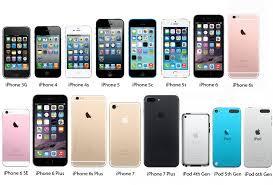About to sell your iPhone back to Buy Certified Used iPhones to upgrade, but don’t know which iPhone model you own? While some models are very similar, there are subtle differences that will allow you to more easily identify which one it is.
Why is this important? There are substantial differences in offer prices from model to model, especially with older iPhones. If you misidentify it, you might be cheating yourself out of a good deal of money! We’ve compiled this list to help you figure out which model you own.
IPhone 6S - Introduced 2015
Apple produced two models of the iPhone 6S: the 4.7-inch iPhone 6S and the 5.5-inch iPhone plus. The first distinctive mark is an “S” engraved into the aluminum back of the device near the bottom. It may come in one of four colors: space gray, silver, gold, and rose gold (which is pink in hue). Either phone will have a flat glass screen with curved edges and Touch ID. The IMEI is located on the SIM tray and not on the back cover like older models.
Look for any of these model numbers on the back cover: A1633, A1688, and A1700 for the 6S; and A1634, A1687, and A1699 for the 6S Plus.
iPhone 6 - Introduced 2014
The iPhone 6 is nearly identical to the 6S as it also came in 4.7-inch and 5.5-model models. Only three colors were available with this generation: space gray, silver, and gold. Like the 6S it has a flat glass screen with curved edges and Touch ID, but on the aluminum back there will be no “S” marking. The IMEI number is also in a different place: here it is etched on the back cover.
Model numbers for iPhone 6 devices are the following: A1549, A1586, and A1589 for the iPhone 6; and A 1522, A1524, and A1593 for the 6 Plus.
iPhone 5S - Introduced 2013
iPhone 5S models have a 4-inch screen and feature a flat glass front and an anodized aluminum back. Three color options were available: space gray, silver, or gold. A key way to tell this apart from the iPhone 5 is the inclusion of the Touch ID button (in fact, it was the first iPhone to do so). The device also has a distinctive “candy bar” like shape with rounded edges. The IMEI number is found on the back.
Look for these iPhone model numbers on the back cover of the device: A1453, A1457, A1518, A1528, A1530, or A1533.
iPhone 5C - Introduced 2013
The iPhone 5Cs features a polycarbonate back in either of five colors: white, blue, pink, green or yellow. The front of the device sports a four-inch screen encased in flat glass, and you’ll spot the traditional home button found on early iPhones. The IMEI number is also on the back of this device.
Here is the model numbers you’ll find on the back cover of an iPhone 5C: A1456, A1507, A1516, A1529, and A1532.
An iPhone 5 appears similar to a 5S, however, there is not a Touch ID home button. There is also no gold model, just black and white (the white iPhone 5 is the same a what Apple late refers to as silver in the 5S). The design of the phone is relatively unchanged otherwise.
A1428, A1429, and A1442 are the model numbers associated with the iPhone 5.
iPhone 4S devices feature a glass front and back, and were only available in either white or black. They also have a smaller 3.7-inch screen with volume up and down buttons marked with “+” and “-“.
Model numbers found on the back of iPhone 4S will be A1431 or A1387.
The iPhone 4 appears similar to the iPhone 4S in design. You will need to use the model numbers on the back, either A1349 or A1332 to tell them apart from a 4S. Note that the CDMA version of the iPhone 4 will have no SIM tray.
Now that you know which model iPhone you have, you can check what prices your used iPhones are being sold in the market by visiting, JemJem.com.

